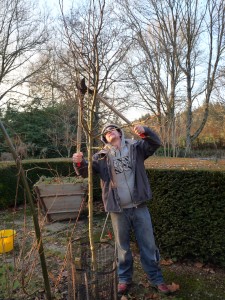In the UK it is winter right up until early March and fruit trees and bushes are in their dormancy period, making this a perfect time to get pruning. During this dormancy the sap has not yet risen so cuts can be made without the tree or bush ‘bleeding’ to death.

Some important things to remember–
- Make sure your tools are sharp and right for the job. For example, don’t use secateurs for large branches, or a saw for thin spindly growth.
- Leave alone members of the plum family, including plums, peaches, apricots until summer to avoid canker.
- Cut out dead, dying and diseased along with any crossing branches. Remove any branches with canker and sterilise your secateurs/loppers afterwards with surgical sprit or similar (can even be vodka!).
- Don’t over prune only cut – 15%-20% for fruit trees (pears and apples) and 30% for fruit bushes. If a lot of work is needed to reshape a tree it can also be done in the following year.
- Try and cut to outward facing buds or buds facing an area without any growth. Always cut slightly above the bud.
- Burn any diseased prunings, rest can be composted.
Specific advice for specific plants –
- Blackcurrants fruit on the last year’s wood so, unless the plant needs major surgery to correct its shape try and maintain some of last year’s wood.
- Gooseberries – Cut 1/3 of new growth to maintain shape
- Pears grow better on horizontal branches so try and maintain these
- Make sure you know if your fruit is a tip or spur bearer and don’t remove the tips if it is the former
- Cut autumn raspberries to the base
Pruning fruit trees and bushes will promote growth and maintain form. It seems counter intuitive but sometimes the more badly a tree or bush is doing the more it will need pruning as you want to promote vigorous new, healthy growth. Each variety is different, look how a tree/bush has responded to pruning in previous years (usually the darker the wood the older it is) and prune accordingly.
The only real way to learn is to do it and see how your tree or shrub responds. You might not get it right in the first year but if you monitor what happens then in subsequent years you’ll learn to get it right. Often the worse that can happen is you won’t get much fruit for one year.
Dave’s new book Grow your food for free, well almost will be available from April 2011.
Article written by Dave Hamilton. Dave has now left Selfsufficientish but you can catch up with him on davehamilton.me.uk or on twitter @davewildish
